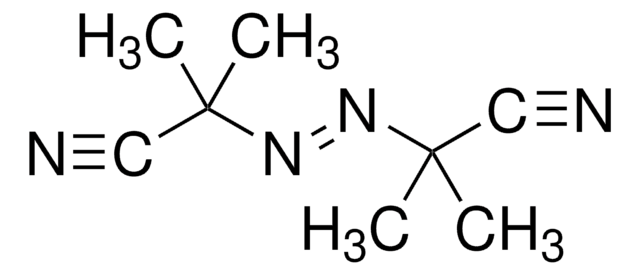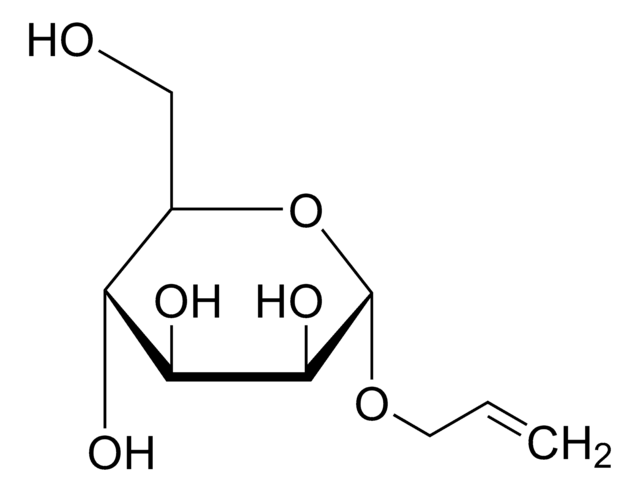8.14444
1-Octadecanethiol
for synthesis
Sinonimo/i:
1-Octadecanethiol, n-Octadecyl mercaptan, Stearyl mercaptane
About This Item
Prodotti consigliati
Tensione di vapore
<0.5 hPa ( 20 °C)
Livello qualitativo
Saggio
≥98.0% (GC)
Stato
solid
Temp. autoaccensione
>200 °C
Potenza
>5000 mg/kg LD50, oral (Rat)
>2000 mg/kg LD50, skin (Rat)
P. ebollizione
366 °C
Punto di fusione
28-31 °C
Temp. transizione
flash point 185 °C
Densità
0.847 g/cm3 at 20 °C
Temperatura di conservazione
2-30°C
Stringa SMILE
SCCCCCCCCCCCCCCCCCC
InChI
1S/C18H38S/c1-2-3-4-5-6-7-8-9-10-11-12-13-14-15-16-17-18-19/h19H,2-18H2,1H3
QJAOYSPHSNGHNC-UHFFFAOYSA-N
Applicazioni
- Self-Assembled 1-Octadecanethiol Membrane on Pd/ZnO for a Selective Room Temperature Flexible Hydrogen Sensor: This study explores the use of 1-octadecanethiol in the development of a selective room temperature hydrogen sensor, demonstrating its potential in enhancing sensor performance (Pathak, Cho, 2021).
- Property improvement of GaAs surface by 1-octadecanethiol passivation: The article investigates the impact of 1-Octadecanethiol passivation on GaAs surfaces, revealing improvements in surface properties and potential applications in semiconductor technologies (Zhou et al., 2019).
- Sputtering synthesis and optical investigation of octadecanethiol-protected fluorescent Au nanoparticles: This research examines the optical properties of gold nanoparticles protected by 1-octadecanethiol, highlighting their potential in various optical and electronic applications (Ishida et al., 2015).
- Kinetics of radical telomerization of acrylic acid in the presence of 1-octadecanethiol: The study focuses on the telomerization process of acrylic acid with 1-octadecanethiol, offering insights into the polymerization kinetics and applications in polymer science (Mezhuev et al., 2018).
- Formation of a mixed monolayer on a gold surface using fluorobenzenethiol and alkanethiol: This article describes the formation of mixed monolayers using 1-octadecanethiol, which could be crucial for developing advanced molecular assemblies on gold surfaces (Ikematsu et al., 2019).
Risultati analitici
Appearance of substance (visual): turbidity
Melting range (lower value): ≥ 28 °C
Melting range (upper value): ≤ 32 °C
Identity (IR): passes test
Due to its specific melting range the product may be solid, liquid, a solidified melt or a supercooled melt.
Avvertenze
Warning
Indicazioni di pericolo
Consigli di prudenza
Classi di pericolo
Aquatic Acute 1 - Skin Irrit. 2
Codice della classe di stoccaggio
11 - Combustible Solids
Classe di pericolosità dell'acqua (WGK)
WGK 3
Punto d’infiammabilità (°F)
Not applicable
Punto d’infiammabilità (°C)
Not applicable
Certificati d'analisi (COA)
Cerca il Certificati d'analisi (COA) digitando il numero di lotto/batch corrispondente. I numeri di lotto o di batch sono stampati sull'etichetta dei prodotti dopo la parola ‘Lotto’ o ‘Batch’.
Possiedi già questo prodotto?
I documenti relativi ai prodotti acquistati recentemente sono disponibili nell’Archivio dei documenti.
Il team dei nostri ricercatori vanta grande esperienza in tutte le aree della ricerca quali Life Science, scienza dei materiali, sintesi chimica, cromatografia, discipline analitiche, ecc..
Contatta l'Assistenza Tecnica.









